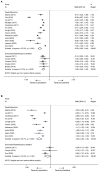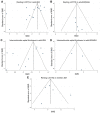Endocardial Radiofrequency Ablation vs. Septal Myectomy in Patients With Hypertrophic Obstructive Cardiomyopathy: A Systematic Review and Meta-Analysis
- PMID: 35558385
- PMCID: PMC9086505
- DOI: 10.3389/fsurg.2022.859205
Endocardial Radiofrequency Ablation vs. Septal Myectomy in Patients With Hypertrophic Obstructive Cardiomyopathy: A Systematic Review and Meta-Analysis
Abstract
Background: Septal myectomy (SM) has been the gold standard therapy for most patients with hypertrophic obstructive cardiomyopathy (HOCM). Endocardial radiofrequency ablation of septal hypertrophy (ERASH) is a novel treatment for septal reduction. We aimed to assess the efficacy and safety between two treatment strategies.
Methods: We searched PubMed, Web of Science, Cochrane Library, and Embase databases to identify relevant studies published up to March 2021. Random-effect models were used to calculate standardized mean difference (SMD) and 95% confidence intervals (CIs) for resting left ventricular outflow tract gradient (LVOTG) and septal thickness.
Results: Twenty-five studies are included in this review, eighteen studies for SM and seven studies for ERASH. During follow-up, there were significant reductions of the mean resting LVOTG in adults (SM groups: SMD = -3.03, 95% CI [-3.62 to -2.44]; ERASH groups: SMD = -1.95, 95% CI [-2.45 to -1.45]) and children (SM groups: SMD = -2.67, 95% CI [-3.21 to -2.12]; ERASH groups: SMD= -2.37, 95% CI [-3.02 to -1.73]) after the septal reduction therapies. For adults, SM groups contributed to more obvious reduction than ERASH groups in interventricular septal thickness (SM groups: SMD = -1.82, 95% CI [-2.29 to -1.34]; ERASH groups: SMD = -0.43, 95% CI [-1.00 to 0.13]). The improvement of the New York Heart Association class was similar in the two groups (SM groups: 46.4%; ERASH groups: 46.7%). The periprocedural mortality in SM and ERASH were 1.1 and 1.8%, respectively.
Conclusions: This systematic review suggests that SM is superior to ERASH in the treatment of HOCM. But for the patients who are at risk for open cardiac surgeries or prefer a less invasive approach, ERASH might be an optional approach.
Keywords: endocardial radiofrequency ablation; hypertrophic obstructive cardiomyopathy; meta-analysis; septal myectomy; systematic review.
Copyright © 2022 Jiang, Huang, Huo, Mageta, Guo, Lv and Lin.
Conflict of interest statement
The authors declare that the research was conducted in the absence of any commercial or financial relationships that could be construed as a potential conflict of interest.
Figures




Similar articles
-
Acute and chronic effects of endocardial radiofrequency ablation of septal hypertrophy in HOCM.J Cardiovasc Electrophysiol. 2021 Oct;32(10):2617-2624. doi: 10.1111/jce.15203. Epub 2021 Aug 16. J Cardiovasc Electrophysiol. 2021. PMID: 34379341
-
From 100 to 0: Endocardial Radiofrequency Ablation of Septal Hypertrophy for Management of Hypertrophic Cardiomyopathy.JACC Case Rep. 2020 Jul 15;2(8):1173-1177. doi: 10.1016/j.jaccas.2020.05.042. eCollection 2020 Jul. JACC Case Rep. 2020. PMID: 34317442 Free PMC article.
-
Alcohol Septal Ablation or Septal Myectomy? An Updated Systematic Review and Meta-Analysis of Septal Reduction Therapy for Hypertrophic Obstructive Cardiomyopathy.Front Cardiovasc Med. 2022 May 25;9:900469. doi: 10.3389/fcvm.2022.900469. eCollection 2022. Front Cardiovasc Med. 2022. PMID: 35694661 Free PMC article.
-
Efficacy and safety of radiofrequency ablation for hypertrophic obstructive cardiomyopathy: A systematic review and meta-analysis.Clin Cardiol. 2020 May;43(5):450-458. doi: 10.1002/clc.23341. Epub 2020 Feb 7. Clin Cardiol. 2020. PMID: 32034788 Free PMC article.
-
Alcohol Septal Ablation versus Septal Myectomy Treatment of Obstructive Hypertrophic Cardiomyopathy: A Systematic Review and Meta-Analysis.J Clin Med. 2020 Sep 23;9(10):3062. doi: 10.3390/jcm9103062. J Clin Med. 2020. PMID: 32977442 Free PMC article. Review.
Cited by
-
Guidelines on the Diagnosis and Treatment of Hypertrophic Cardiomyopathy - 2024.Arq Bras Cardiol. 2024 Jul 26;121(7):e202400415. doi: 10.36660/abc.20240415. Arq Bras Cardiol. 2024. PMID: 39082572 Free PMC article. English, Portuguese. No abstract available.
-
A Narrative Review of Emerging Therapies for Hypertrophic Obstructive Cardiomyopathy.Curr Cardiol Rev. 2023;19(4):e240323214927. doi: 10.2174/1573403X19666230324102828. Curr Cardiol Rev. 2023. PMID: 36999417 Free PMC article. Review.
-
Radiofrequency ablation in patients with obstructive hypertrophic cardiomyopathy: A systematic review and meta-analysis.Am Heart J Plus. 2022 Nov 17;24:100229. doi: 10.1016/j.ahjo.2022.100229. eCollection 2022 Dec. Am Heart J Plus. 2022. PMID: 38560638 Free PMC article. Review.
-
Percutaneous endocardial septal radiofrequency ablation in patients with hypertrophic obstructive cardiomyopathy.BMC Cardiovasc Disord. 2025 Aug 2;25(1):564. doi: 10.1186/s12872-025-05002-1. BMC Cardiovasc Disord. 2025. PMID: 40753187 Free PMC article.
-
Recent Clinical Updates of Hypertrophic Cardiomyopathy and Future Therapeutic Strategies.Rev Cardiovasc Med. 2025 Feb 20;26(2):25132. doi: 10.31083/RCM25132. eCollection 2025 Feb. Rev Cardiovasc Med. 2025. PMID: 40026515 Free PMC article. Review.
References
-
- Poon SS, Cooper RM, Gupta D. Endocardial radiofrequency septal ablation - A new option for non-surgical septal reduction in patients with hypertrophic obstructive cardiomyopathy (HOCM)?: a systematic review of clinical studies. Int J Cardiol. (2016) 222:772–4. 10.1016/j.ijcard.2016.08.123 - DOI - PubMed
Publication types
LinkOut - more resources
Full Text Sources

